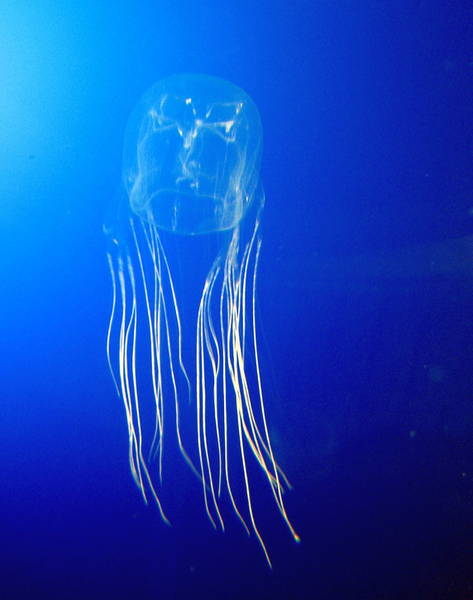Hello ladies and gents this is the Viking telling you that today we are talking about
BOX JELLYFISH
The medusa form of a box jellyfish has a squarish, box-like bell, from which its name is derived. From each of the four lower corners of this hangs a short pedalium or stalk which bears one or more long, slender, hollow tentacles. The rim of the bell is folded inwards to form a shelf known as a velarium which restricts the bell's aperture and creates a powerful jet when the bell pulsates. As a result, box jellyfish can move more rapidly than other jellyfish; speeds of up to 6 metres (20 ft) per minute have been recorded.
In the center of the underside of the bell is a mobile appendage called the manubrium which somewhat resembles an elephant's trunk. At its tip is the mouth. The interior of the bell is known as the gastrovascular cavity. It is divided by four equidistant septa into a central stomach and four gastric pockets.
The eight gonads are located in pairs on either side of the four septa. The margins of the septa bear bundles of small gastric filaments which house nematocysts and digestive glands and help to subdue prey. Each septum is extended into a septal funnel that opens onto the oral surface and facilitates the flow of fluid into and out of the animal.
The box jellyfish's nervous system is more developed than that of many other jellyfish. They possess a nerve ring around the base of the bell that coordinates their pulsing movements, a feature found elsewhere only in the crown jellyfish. Whereas some other jellyfish have simple pigment-cup ocelli, box jellyfish are unique in the possession of true eyes, complete with retinas, corneas and lenses. Their eyes are set in clusters called rhopalia, located in pockets halfway up the outer, flat surfaces of the bell.
Each contains two rhopalial ocelli with lenses, one directed upwards and the other downwards and inwards towards the manubrium. This enables the animal to see specific points of light, as opposed to simply distinguishing between light and dark. Box jellyfish also have twenty ocelli (simple eyes) that do not form images, but detect light and dark; they therefore have a total of twenty-four eyes. Near the rhopalia are statoliths which detect gravitational pull and help the animal to orient itself.
Box jellyfish also display complex, probably visually-guided behaviors such as obstacle avoidance and fast directional swimming. Research indicates that, owing to the number of rhopalial nerve cells and their overall arrangement, visual processing and integration at least partly happen within the rhopalia of box jellyfish. The complex nervous system supports a relatively advanced sensory system compared to other jellyfish, and box jellyfish have been described as having an active, fish-like behavior.
A fully grown box jellyfish can measure up to 20 cm (8 in) along each box side (30 cm or 12 in in diameter), and the tentacles can grow up to 3 m (10 ft) in length. Its weight can reach 2 kg (4 1⁄2 lb). There are about 15 tentacles on each corner. Each tentacle has about 500,000 cnidocytes, containing nematocysts, a harpoon-shaped microscopic mechanism that injects venom into the victim. Many different kinds of nematocysts are found in cubozoans

Comments
Post a Comment